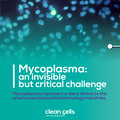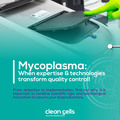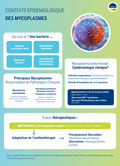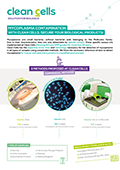

Clean Cells and bioMérieux have joined forced to fight back using BIOFIRE®
In the challenging world of biomanufacturing and advanced therapies, the detection of mycoplasma is critical to ensuring the safety of biological products and the protection of patients. Invisible to the naked eye and particularly difficult to detect, these microbial contaminants can compromise the quality of medicines, lead to significant financial losses, and delay the market launch of essential therapeutic solutions.
Faced with these challenges, industries need reliable, rapid solutions that comply with global regulatory requirements. With this in mind, Clean Cells, in collaboration with bioMérieux, has adopted the BIOFIRE® platform, to meet the growing expectations of its customers.
Mycoplasma: an invisible but critical challenge
Mycoplasmas are atypical and insidious micro-organisms, very different from classic bacteria:
- No cell membrane: their simple, flexible structure makes them resistant to many antibiotics, particularly those that target the bacterial wall ;
- Extremely small size: their small size (0.2 to 0.8 µm) allows them to pass through filters that usually stop other bacteria, making them difficult to eliminate.
- Slow growth and difficult to detect: mycoplasmas require specific culture media and a long time to develop, which often delays their identification.
These characteristics make mycoplasmas an invisible enemy, capable of contaminating cell cultures without altering their macroscopic appearance, making detection even more complex.
Mycoplasma contamination has major repercussions in the pharmaceutical and biotechnology industries:
- Product safety issues: Mycoplasma can alter the biological properties of cell cultures, affecting the quality and efficacy of drugs, vaccines or gene therapies.
- Production delays and costs: Late detection of contamination can lead to considerable delays, the destruction of entire batches and high financial costs.
A study carried out in academic and industrial laboratories revealed that up to 1% of cell cultures in well-controlled laboratories and 15% under less stringent conditions were contaminated with mycoplasma, illustrating the scale of this challenge.
The pharmaceutical industry is guided by stringent regulatory frameworks, with over 40 global pharmacopoeial texts ensuring products safety. Effectively, mycoplasma detection tests are required by the European (EP 2.6.7), American (USP <63>) and Japanese (JP 17) pharmacopoeias, covering biological products intended for global markets.
Clean Cells is at the forefront of these developments, offering expertise in the latest Pharmacopeias and innovative approaches needed to ensure the safety of your biological products.
Compendial methods: robusts but improvable
Compendial methods, such as Direct Culture or Indirect Culture, offer a solid basis for safety, but have certain limitations in a demanding industrial & are no more sufficient to meet the growing needs of manufacturers:
- The increasing need to reduce lead times in order to avoid production delays and speed up time-to-market.
- Increasing complexity of biological products: Cell and gene therapies require more sensitive and specific approaches.
- Stricter regulations: The growth of products destined for global markets requires greater standardisation of analyses.
Faced with these challenges, it is becoming imperative to integrate modern technologies capable of combining speed, reliability and compliance.
NAT methods in compliance with new regulations
& current challenges
Faced with the limitations of traditional methods, modern approaches such as the Nucleid Acid Testing methods (NAT Methods) (like qPCR method or BIOFIRE®), deliver faster, more reliable, and adaptable solutions, perfectly aligned with today’s industrial needs.
Clean Cells and bioMérieux have joined forced to fight back using BIOFIRE®, to offer a solution that meets industry expectations. This collaboration is based on complementary expertise.
BIOFIRE® is a molecular diagnostic solution based on integrated multiplex PCR technology. The system is designed to offer a rapid, high-performance alternative to conventional methods: Fast & automated detection, multiplex capability, easy to use.
This solution offers considerable advantages for our customers and partners:
- Significant time savings,
- Improved reliability and sensitivity,
- Accurate detection,
- Applicable to a wide range of biological products,
- Adaptable to the specificities of industrial workflows,
- Process simplification…
In addition, BIOFIRE® meets pharmacopoeial requirements for mycoplasma testing, while offering the flexibility to be integrated into GMP processes.
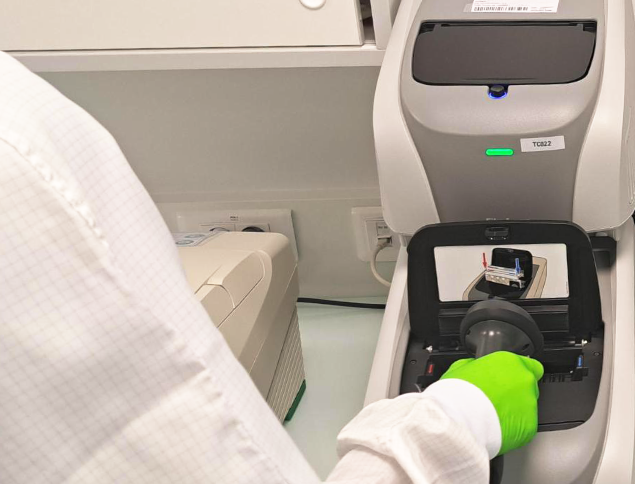
At Clean Cells, mycoplasma detection is more than just a service: it is one of the company’s historic activities, developed from the company’s commitment to meet the requirements of the pharmaceutical and biotechnology industries.
With decades of experience built up, Clean Cells has established recognised expertise in mycoplasma detection, identification and control, adopting innovative technologies at every stage of its evolution.
By combining Biofire with its 25 years of expertise, Clean Cells helps its customers to modernise their quality control approaches, while remaining compliant with global standards.
To find out more about our methods and capabilities, visit our dedicated page:
